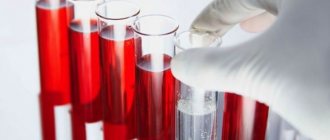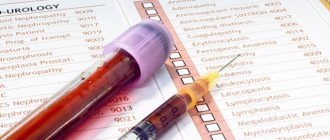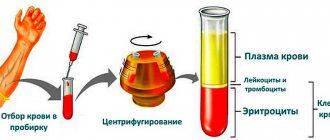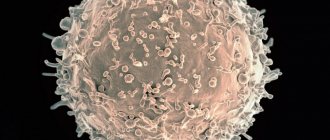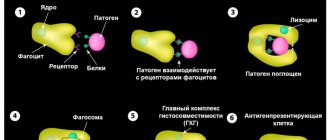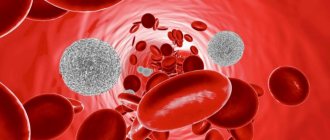Decoding the results is the competence of a pediatrician, therapist or specialist, since it is important not only to analyze the numbers, but also to compare deviations from the norms of different indicators, to compare the information obtained during examination and history taking. To have an overview and be prepared when you see your doctor, learn what blood elements are tested in the laboratory, how to interpret the results, and what abnormalities may mean.
Types of leukocytes
The leukocyte formula reflects the ratio of five main types: lymphocytes, monocytes, neutrophils, basophils, eosinophils. Different types of white blood cells are different in structure and purpose. Depending on whether they contain granules that are capable of perceiving color, leukocytes are of two types: granulocytes, agranulocytes.
Granulocytes include:
- basophils - can perceive alkaline color;
- eosinophils – acidic;
- neutrophils - both types of dyes.
Agranulocytes include:
- two types of lymphocytes (B- and T-lymphocytes);
- monocytes.
Neutrophils
Neutrophils come from red bone marrow, they are formed from a single stem cell, which is the ancestor of all blood cells. However, stem cells do not immediately turn into neutrophils. Between these two forms there are several stages, several intermediate forms.
There are 6 types of neutrophils:
- myeloblasts;
- promyelocytes;
- myelocytes;
- metamyelocytes;
- band neutrophils;
- segmented neutrophils.
Most of all is in the blood of the latter. They are present in an amount of 40–75% of the total number of leukocytes. The number of rod-shaped neutrophils is significantly smaller, they can be 1–6%. The number of young cells does not reach 1%.
Functions of white cells
Lymphocytes. T lymphocytes destroy foreign microorganisms and cancer cells. B lymphocytes are responsible for producing antibodies.
Monocytes. They participate in phagocytosis, directly neutralizing foreign bodies, as well as the immune response and tissue regeneration.
Eosinophils. Capable of active movement and phagocytosis. They actively participate in the formation of inflammatory and allergic reactions, capturing and releasing histamine.
Basophils. They ensure the migration of other types of leukocytes into tissues to the site of inflammation and take part in allergic reactions.
Neutrophils. The main purpose is phagocytic protection, that is, the absorption of foreign bodies. In addition, they release bactericidal substances.
Monocytes are killers in the body
Monocytes make up 10% of white blood cells and perform the main “destructive” function of the immune system. Also called tissue macrophages. They are formed in the bone marrow within 5 days and immediately go out to “hunt” without leaving a reserve. They quickly penetrate tissues and destroy foreign proteins. A large number of monocytes are found in the liver, spleen and lungs. They exist for about 60 days and process foreign proteins into antigens, which are subsequently dealt with by immune cells.
An increase in monocytes in the blood, or monocytosis, indicates that there are chronic infections in the body. They can also talk about infections that are located in the cells themselves: viruses, chlamydia and mycoplasma.
Normal leukogram values
The leukocyte formula of the blood of healthy adults is as follows:
| Kinds | Content % | Absolute value (number of cells X 10?/l) |
| Lymphocytes | 19-37 | 1,2-3 |
| Monocytes | 3-11 | 0,09-0,6 |
| Band neutrophils (immature) | 1-6 | 0,04-0,3 |
| Segmented neutrophils | 47-72 | 2-5,5 |
| Basophils | 0-1 | 0-0,065 |
| Eosinophils | 0,5-5 | 0,02-0,3 |
Changes in the leukogram are usually denoted by terms with specific endings. As the level increases, endings such as “oz” (“ez”) or “ia” are added to the name of a particular type of leukocyte. For example: lymphocytosis, eosinophilia, monocytosis, etc. When the level of leukocytes decreases, it is customary to add the ending “singing” to the name: lymphopenia, neutropenia, eosinopenia, etc.
In this case, a distinction is made between relative and absolute change. In the first case, we are talking about a deviation from the norm in the percentage of leukocytes. In the second, they talk about a deviation from the norm both in percentage terms and in absolute terms, which is understood as a change in the total number of cells per unit volume of blood.
Leukocytes differ in their structure and purpose
It should be said that the leukocyte formula depends on age. This must be taken into account when assessing it during examination and diagnosis of diseases in children.
When is the test prescribed?
A clinical blood test with a leukocyte formula is indicated for patients with various pathologies. It allows you to assess a person’s health status with a comprehensive and timely diagnosis of diseases, including those occurring in a latent form.
Indications for a clinical blood test with a leukocyte formula are:
- medical examination or routine medical examination;
- preparation for surgical treatment;
- infection or suspected infection;
- suspicion of inflammation or parasitic infestation in the patient’s body;
- allergic reactions;
- prescribing certain medications;
- monitoring the effectiveness of treatment.
Before donating capillary blood, it is recommended not to drink alcohol during the day, not to eat for 2-3 hours, not to smoke for 30 minutes and to avoid stress and excessive physical activity.
How to determine
The leukocyte formula is calculated by a laboratory assistant by viewing the blood under a microscope (leukogram count per hundred cells).
In addition, a hematology automatic analyzer is used. In case of deviations from the norm, a microscopic examination of the smear is additionally carried out, while the morphology of the cells is described and the leukogram is clarified.
The use of automatic equipment allows you to obtain the most accurate result: more than 2000 cells can be analyzed, while under a microscope - a maximum of 200. When examined using an analyzer, the result is more objective.
Automatic counting also has a drawback: the inability to divide neutrophils into segmented and band neutrophils. But in the case of a large number of young forms, the equipment records a shift to the left.
Where are lymphocytes born?
It has been proven that these cells have 2 main places of birth: lymph nodes and the thymus gland.
Groups of lymph nodes are scattered throughout the body, but they supply only 10 to 15% of the total number of lymphocytes in the blood. They are called B lymphocytes. These cells, having once encountered a foreign microorganism, remember it and organize its destruction. The property is passed on “by inheritance” to subsequent generations. In this way, artificial immunity to vaccinations is formed, while the foreign antigen is weakened pathogens of various diseases.
Thymus gland (thymus) - located behind the upper edge of the sternum
In a newborn, the thymus weighs only 15 g, grows to 27-30 g by the age of 15, and then begins to gradually atrophy. Therefore, the number of lymphocytes in the blood of a child immediately after birth is at its maximum level, then decreases.
The important role of the thymus in immunity is to produce up to 80% of all blood lymphocytes. This type is called T lymphocytes. They are the ones who carry out “organizational” work in the immune system and prepare an attack on foreign microorganisms.
Reasons for changes in leukogram
An increase in the level of lymphocytes (lymphocytosis) is observed in the following pathologies:
- acute viral infections: chickenpox, measles, mononucleosis, rubella;
- chronic bacterial infections: syphilis, brucellosis, tuberculosis;
- lymphomas, lymphosarcoma, lymphocytic leukemia;
- hyperthyroidism (thyrotoxicosis);
- adrenal insufficiency;
- folate deficiency anemia;
- aplastic and hypoplastic anemia.
Lymphocytopenia can develop for the following reasons:
- acute infections;
- lymphogranulomatosis;
- systemic lupus erythematosus;
- renal failure;
- immunodeficiency;
- radiation sickness (acute form);
- taking corticosteroids.
An increase in the level of neutrophils in the blood (neutrophilia) is observed in the following conditions:
- bleeding is acute;
- intoxication;
- bacterial diseases in acute forms;
- taking corticosteroids;
- tissue necrosis.
The content of neutrophils decreases for the following reasons:
- bacterial infections: typhoid fever, brucellosis, tularemia;
- viral infections: measles, hepatitis, rubella;
- toxic effects to which the bone marrow is exposed: drugs, ionizing radiation;
- autoimmune diseases;
- hypersensitivity to medications;
- Benign chronic neutropenia is hereditary.
Monocytosis, in which the level of monocytes in the blood is increased, may indicate the following disorders:
- subacute, chronic infections caused by bacteria;
- hemoblastoses;
- systemic autoimmune diseases: rheumatoid arthritis, lupus erythematosus, sarcoidosis;
- parasitic infections.
A low level of monocytes is assessed in combination with lymphocyte indicators, which is important when diagnosing pulmonary tuberculosis.
Basophilia (increased levels of basophils in the blood) is observed in chronic myeloid leukemia and erythremia.
An increased level of eosinophils is observed in the following conditions:
- allergies;
- Loeffler's endocarditis;
- scarlet fever;
- parasitic infections;
- chronic skin diseases: eczema, psoriasis;
- eosinophilic leukemias;
- recovery phase of infectious diseases.
Causes of low eosinophil levels (eosinopenia) may include:
- typhoid fever;
- increased adrenocorticosteroid activity.
Is it possible to normalize the number of lymphocytes?
Physiological changes in blood composition return to normal after the elimination of the infectious focus, signs of inflammation, withdrawal of medications, and removal of intoxication in case of poisoning.
Natural ginseng root
During the recovery period after an infectious disease, to support the immune system, you can take herbal remedies such as tinctures of ginseng, eleutherococcus, aloe, and honey. These are weak immunomodulatory agents. Vitamin-mineral complexes and a diet rich in proteins help normalize hematopoiesis.
If lymphopenia or lymphocytosis is associated with chronic diseases, then long-term treatment will be required, possibly blood transfusion. It is not recommended to independently choose medications that affect the immune system.
The effect of cytostatic and radiation therapy for malignant neoplasms is based on the destruction of atypical cells. But, unfortunately, blood cells also disappear at the same time. Modern treatment regimens provide for a minimal effect on hematopoiesis. Only a specialist doctor can control the prescription of medications.
Leukogram shift
Modern automatic blood analyzers quickly and accurately calculate the complete leukocyte formula, which greatly facilitates diagnosis
When the leukogram is deciphered, nuclear shifts are taken into account. These are changes in the ratio of mature and immature neutrophils. In the blood formula, the different forms of neutrophils are listed in order from young to mature (from left to right).
There are three types of shifts: left, left with rejuvenation, and right.
With a left shift, myelocytes and metamyelocytes are present in the blood. This change occurs through the following processes:
- acute inflammation: pyelonephritis, prostatitis, orchitis;
- purulent infections;
- acidosis;
- bleeding is acute;
- poisoning with toxins;
- high physical activity.
With a left shift with rejuvenation, forms such as myelocytes, metamyelocytes, promyelocytes, myeloblasts, and erythroblasts can be found in the blood. This is observed in conditions such as:
- leukemia (chronic, acute);
- erythroleukemia;
- metastases;
- myelofibrosis;
- coma.
Video about the types and functions of leukocytes:
With a decrease in the number of band (immature) neutrophils and an increase in the level of segmented (mature forms containing 5-6 segments), they speak of a right shift. With such a change in the leukogram, we can talk about the following pathologies and conditions:
- liver and kidney diseases;
- megaloblastic anemia;
- consequences of blood transfusion;
- radiation sickness;
- vitamin B12 deficiency, folate deficiency anemia.
The degree of shift is assessed using a special index, which is determined by the ratio of the total number of all young neutrophils (myelocytes, metamyelocytes, promyelocytes, band neutrophils) to mature segmented ones. The norms for healthy adults are in the range of 0.05-0.1.
Why is a leukocyte blood formula needed?
The leukocyte formula is the percentage of leukocytes in the blood serum (eosinophils, neutrophils, lymphocytes, basophils, monocytes).
This analysis allows you to determine the current state of the immune system, identify inflammatory processes in the patient’s body and determine the etiology of allergies. It is known that leukocytes protect the human body from dangerous microorganisms. One of the main tasks of leukocytes is the destruction of foreign particles. If an inflammatory process occurs in the patient’s body, it is immediately reflected in the leukocyte count.
Complete blood count (CBC/Diff - 5 fractions of leukocytes) - capillary blood in Moscow from day 1
from 290 ₽
Sign up
Clinical blood test (CBC/Diff - 5 leukocyte fractions) + ESR in Moscow from day 1
from 294 ₽
Sign up
Complete blood count (CBC/Diff - 5 fractions of leukocytes) in Moscow from 1 weekday
from 290 ₽
Sign up
When leukocyte counts change in the blood, it is necessary to determine in which direction the deviation occurs. This study will help you quickly find the problem and make a diagnosis. However, it should be taken into account that changes in blood parameters without in-depth diagnostics are not a characteristic and final sign for making a diagnosis.


